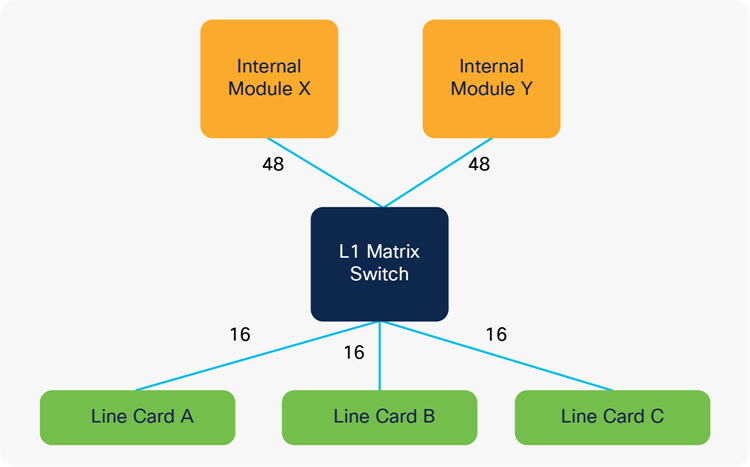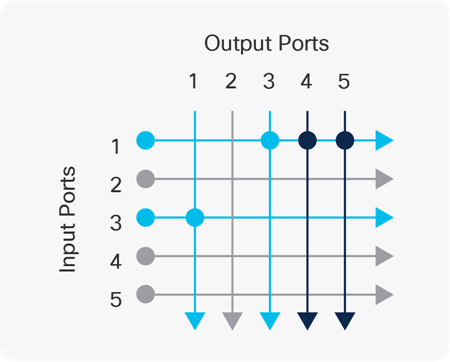Cisco Nexus 3550-F Modular L1 Matrix Switch and Programmable Multiplexer Switch Data Sheet
Available Languages
Bias-Free Language
The documentation set for this product strives to use bias-free language. For the purposes of this documentation set, bias-free is defined as language that does not imply discrimination based on age, disability, gender, racial identity, ethnic identity, sexual orientation, socioeconomic status, and intersectionality. Exceptions may be present in the documentation due to language that is hardcoded in the user interfaces of the product software, language used based on RFP documentation, or language that is used by a referenced third-party product. Learn more about how Cisco is using Inclusive Language.
A flexible low latency networking platform
The Cisco Nexus® 3550-F products are a compact yet powerful networking platform designed specifically for low-latency applications. The Nexus 3550-F products feature up to 48 ports of 10G Ethernet connectivity in a single-rack-unit form factor that can be configured as follows:
● Cisco Nexus 3550-F Modular Layer 1 Matrix Switch is purpose-built for low-latency data fan-out, electronic patch panels, and transparent monitoring applications. Layer 1 switching offers port-to-port latencies under 5ns.
● Cisco Nexus 3550-F Programmable Multiplexer Switch is designed to support multiple multiplexing modes for many-to-one aggregation use cases. Applications include low-latency link aggregation for financial trading order entry networks and low-latency telecommunications networks. This mode offers latencies as low as 39ns.
Scalable modular architecture
The Cisco Nexus 3550-F products are built with a unique modular architecture that scales with your network. Three-line card bays provide the flexibility to grow and change connectivity options over time, while two internal module bays allow the device to be upgraded with expanded functionality, adding new capabilities and extending the useful life of the product. The 3550-F architecture is shown in the figure below (Figure 1). At the heart of the architecture is a high-density Layer 1 matrix switch. This matrix switch provides low-latency programmable 10GbE connectivity between all modules.

Cisco Nexus 3550-F modular architecture
The external module bays (A, B, and C) can be populated with a 16-port SFP+ line card (N35-F-16P) and/or a 4-port QSFP+ line card (N35-F-4Q). Standard SFP+ and QSFP+ optics or cable connectivity options are available.
The internal modules bays are unpopulated for Layer 1 only use. A high-density FPGA (N35-F-KU115) module is included for Layer 2 Mux application. For custom applications, multiple FPGAs and/or multiple X86 CPU modules (N35-F-SKL) can be installed and programmed.
Ease of use and manageability
The Cisco Nexus 3550-F products use a custom operating system and Command Line Interface (CLI), designed specifically to address the needs of layer 1 switching and low latency FPGA configuration. Every command available on the CLI is also available via a remote JSON RPC API making this device easy to operate and manage at scale.
All Cisco Nexus 3550-F products include standard enterprise manageability and deployment features including automatic configuration (via DHCP), SNMP, TACACS+ authentication, on-board python programmability, BASH shell access and time series logging.
Cisco Nexus 3550-F Modular Layer 1 Matrix Switch
Unlike traditional network switches that operate only at the data-link layer (Layer 2), the Cisco Nexus 3550-F Modular Layer 1 Matrix Switch can operate at the physical network Layer 1 to provide the benefits of circuit switching to Ethernet devices. Connections through the switch are programmed into a matrix switch (see Figure 2) ahead of time and remain configured indefinitely. Unlike dynamic packet-based switching, this has the advantage of providing very low and deterministic latency. Packets can cross a Layer 1 matrix switch in under 5ns (from port to port).
The Cisco Nexus 3550-F Modular Layer 1 Matrix Switch has several useful purposes. It allows the device to tap into connections (for near transparent network monitoring), to patch connections between ports (for electronic network reconfiguration) and to fan-out connections from one port to many (for low latency data replication applications).

Cisco Nexus 3550-F Modular Layer 1 Matrix Switch configuration
Figure 2, above, illustrates an example configuration of a Layer 1 matrix switch:
● A “patch” is configured between ports 1 and 3: all traffic from port 1 is directed to port 3, all traffic from port 3 is directed to port 1. This patch can be
● Two “taps” are configured from port 1 to ports 4 and 5: traffic from port 1 is replicated to ports 4 and 5 at latencies as low as 2.8ns. Typically, such low latencies would be viewed as transparent to other network devices.
Transparent tapping
Network monitoring is vital for logging, debugging and compliance. While optical taps can be used for low latency network inspection, they consume valuable rack space and cannot be remotely managed. The Cisco Nexus 3550-F Modular Layer 1 Matrix Switch replaces 16 optical taps (48 ports) in a single 1RU device. Taps through the Cisco Nexus 3550-F Modular Layer 1 Matrix Switch employ active signal regeneration so that the signal quality remains high while port-to-port latencies are as low.
An electronic patch panel
Network reconfiguration is a fact of life, yet colocation access is often expensive and sometimes impossible (for example, during business hours). The Cisco Nexus 3550-F Modular Layer 1 Matrix Switch offers a fast and convenient tool for managing and reconfiguring a physical network, remotely and at any time of the day, yet adds nearly no overhead. The remote JSON RPC API allows for such changes to be simply automated and controlled by a logically central controller.
Packet-aware statistics and monitoring
Although the Cisco Nexus 3550-F Modular Layer 1 Matrix Switch operates at the physical layer, it is fully packet aware. Every port on the device is monitored for vital packet statistics including the number of packets/bytes transmitted/received and transmit/receive errors. The device also provides deep diagnostics including light levels, operating temperatures, transceiver capabilities, and more. All these statistics are available at no latency cost on the critical path.
Cisco Nexus 3550-F Programmable Multiplexer Switch
The Cisco Nexus 3550-F Programmable Multiplexer Switch offers specialized multiplexing/demultiplexing features designed for low-latency applications and telecommunication networks. In the absence of queueing, packets can cross the device in as little as 39ns. This makes the Cisco Nexus 3550-F Programmable Multiplexer Switch one of the fastest multiplexers available in the market.
The Cisco Nexus 3550-F Programmable Multiplexer Switch is superior to typical Ethernet network switches when you need to support low-latency applications, electronic trading networks, and low-latency telecommunication networks. These specialized networks require n-to-1 link aggregation (multiplexing) and 1-to-n link disaggregation (demultiplexing). Ethernet network switches can only perform all-to-all switching, which is slow and expensive for n-to-1 multiplexing and 1-to-n demultiplexing.
Different multiplexers for different requirements
Multiplexing may seem simple in principle, but there are many tradeoffs depending on the use case: What line speeds are required? How many ports are needed? How deep should buffers be for contention? What type of demultiplexing is supported? The Cisco Nexus 3550-F Programmable Multiplexer Switch supports multiple multiplexing modes, each with a different feature and latency tradeoffs, summarized in Table 1.
Table 1. Cisco Nexus 3550-F Programmable Multiplexer Switch mode
| Mode |
Latency (min) |
Link rate(s) |
Total muxes |
Max ports |
Buffer per port |
Demuxing |
| FastMux |
39ns |
10GbE |
4 |
15,11,11,1 |
4kB |
L1 only |
| Mux |
92ns |
1/10GbE |
4 |
48 |
20kB |
L1/L2/VLAN |
The FastMux mode, is the fastest multiplexer available. It offers 10G Ethernet connectivity and limited buffer depth. Demultiplexing is performed by layer 1 broadcast only. The FastMux is designed for applications where contention is low and pure speed is the only objective, such as electronic trading order entry networks.
The Mux mode offers 1G and 10G Ethernet options, with the ability to rate convert between these rates. It also offers Layer 2 and VLAN based demultiplexing. These features are designed for low latency long range wireless telecommunication networks where many customers require access to the same low-speed radio link.

Cisco Nexus 3550-F Modular Layer 1 Matrix Switch / Cisco Nexus 3550-F Programmable Multiplexer Switch
Cisco Nexus 3550-F L1 Switch and Nexus 3550-F Mux feature comparison
The modularity of the Cisco Nexus 3550-F L1 Switch and Nexus 3550-F Mux can be purchased in multiple configurations. Table 2 lists the feature matrix for each configuration.
Table 2. Cisco Nexus 3550-F L1 Switch and Nexus 3550-F Mux feature comparison
| Device |
Layer 1 switching |
Layer 2 muxing |
Layer 2 switching |
Ordering ID |
| Cisco Nexus 3550-F Fusion L1 |
Yes |
|
|
N35-F-48X |
| Cisco Nexus 3550-F Fusion Mux |
Yes |
Yes |
|
N35-FM-48X |
Cisco Nexus 3550-F L1 Switch and Nexus 3550-F Mux product features
Latency
● L1 Tap/Patch: 3ns minimum – 5ns maximum
● FastMux: 39ns minimum – 48ns maximum
● Mux: 92ns minimum – 107ns maximum
● Mux (switch): 86ns minimum – 102ns maximum
Statistics
● Packet counters (RX, TX, dropped etic)
● Per port status LEDs
● Live packet dump
● SFP diagnostics (light levels, temps, etc.)
● SNMP, local and remote syslog
● Time series logging to InfluxDB
Connectivity
● 3x 16 SFP+ line cards, up to 48 ports
● 3x 4QSFP line cards, up to 12 ports (48x10G)
● SFP+ Fiber (10GBASE-SR, 10GBASE-LR, 10GBASE-LRM, 1000BASE-SX, 1000BASE-LX)
● SFP+ Copper Direct Attach
● SMA for PPS in/out
● SMA for GPS in
● RJ45 management port
● RJ45 Industry standard serial port
● USB (for firmware upgrades)
Management
● CLI via serial, SSH, and telnet
● JSON RPC API for all CLI commands
● Automatic configuration via DHCP
● TACACS+ and multiuser support
● ACLs on management interface
● FW updates via SFTP, TFTP, HTTP, and USB
● Onboard BASH and Python scripts
● Onboard Cron jobs
● Time sync via PPS, GPS, PTP, and NTP
General
● 19” 1RU, rack mount
● Weight 11kg (24lbs)
● Dual, hot-swappable supplies
● Standard: AC 90-264V, 47-64 Hz, included IEC C13-C14 cables
● Optional: DC 40-72V
● Maximum consumption: 150W
● Dual hot-swappable fan modules
● Optional airflow direction
● Operating temperature: -5 °C to 45 °C
● Storage temperature: -40 °C to 70 °C
● Operating Relative Humidity: 5% to 90% (non-condensing)
● Storage Relative Humidity: 5% to 95% (non-condensing)
Cisco environmental sustainability
Information about Cisco’s environmental sustainability policies and initiatives for our products, solutions, operations, and extended operations or supply chain is provided in the “Environment Sustainability” section of Cisco’s Corporate Social Responsibility (CSR) Report.
Reference links to information about key environmental sustainability topics (mentioned in the “Environment Sustainability” section of the CSR Report) are provided in the following table:
| Sustainability topic |
Reference |
| Information on product material content laws and regulations |
|
| Information on electronic waste laws and regulations, including products, batteries, and packaging |
Cisco makes the packaging data available for informational purposes only. It may not reflect the most current legal developments, and Cisco does not represent, warrant, or guarantee that it is complete, accurate, or up to date. This information is subject to change without notice.
Flexible payment solutions to help you achieve your objectives
Cisco Capital® makes it easier to get the right technology to achieve your objectives, enable business transformation and help you stay competitive. We can help you reduce the total cost of ownership, conserve capital, and accelerate growth. In more than 100 countries, our flexible payment solutions can help you acquire hardware, software, services and complementary third-party equipment in easy, predictable payments. Learn more.